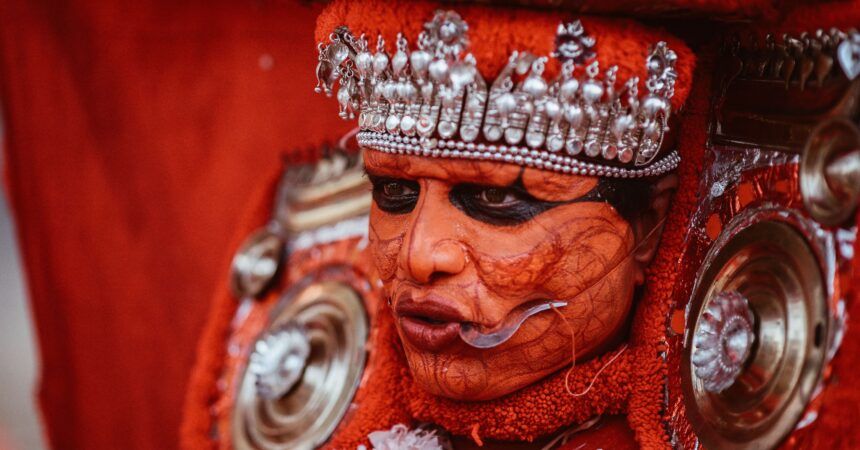One day a little boy called Satyajit Ray who would be one of the greatest filmmakers of all time, went to a legendary poet, Rabindranath Tagore, to get the poet’s autograph. Tagore then wrote a small poem in his diary. Here it is-
“I traveled miles, for many a year,
Spent riches, in lands afar,
I’ve gone to see the mountains, the oceans I’ve been to view.
But I haven’t seen with these eyes
What two steps from my home lies
On a sheaf of paddy grain, a glistening drop of dew.”

This poem speaks a lot about our tendency to overlook the priceless things that we get easily. We Indians wait and invest a lot to visit some famous festivals in foreign countries, but we do not pay heed to the rhythm of our own festivals. People from eastern India hardly know about the Southern Indian festivals like Theyyam or Kaveripattinam Angalamman. Most of the people from the north do not know about Gajan, the festival of Bengal. The festive map of India is vast and diverse. Here we will talk about some Indian festivals that are unique and lesser-known. Here we will talk about the glistening drops of dew that we are yet to explore properly.
John Keats said, “Nothing ever becomes real till it is experienced”. So, experience what the “real” India offers you.
Festivals of India allure foreign tourists. So, they are not only a place or program where different cultures, colors, and languages meet to strengthen the bond of unity, but also a good source of income. From small businesses like handicrafts or local transport to big industries like hotels or international airlines get the economic benefit of such festivals. In the Covid situation, restrictions on festivals is a major reason that has hindered the economic growth of India. Here, Yoof has brought a glimpse of a few such festivals for you. Know your land better- know the spectacular diversity it owns.
Thrissur Pooram:

Though Kerala came to news for the murder of a pregnant elephant last year, it is the same state that celebrates the 200 years old elephant festival of India, known as Thrissur Pooram. In this festival 30, beautifully-adorned elephants parade majestically through the city to reach the Vadakkunnathan temple. This festival was started by Rama Varma IX who invited 10 other temples near Vadakkunnathan temple to join the festival and make it a mass festival of Pooram.
This annual temple festival of Thrissur is celebrated on Pooram day when according to the Malayalam Calendar month of Medam, the moon rises with the Pooram star. Fireworks are another attraction of this Pooram festival and are well-renowned all over the country. The first round of fireworks, known as ‘Sample Vedikettu’ starts on the fourth day after the inaugural flag hoisting. The main round of fireworks takes place in the Thekkinkadu Maidan on the morning of the seventh day. Tourists, visitors, and enthusiasts stay up all night to get a better view of pyrotechnics. Panchavadyam (rhythmic sound of drums) and folk dance also give the visitors a truly immersive experience of Indian festivals.
Hornbill Festival:

The Hornbill Festival, which is a display of traditional extravaganza of Nagaland and its tribes, is also known as the “Festival of Festivals”. The reason behind this name is probably it unites the one and all people of Nagaland and to enjoy week-long activities of cultural performances, crafts, sports, food fairs, and ceremonies. This festival is held every year in the first week of December in the Naga Heritage Village, Kisama. This was started in 2000 by the Government of Nagaland to encourage inter-tribal interactions and to promote cultural heritage. It was named after Indian Hornbill, a large and colorful bird because, in the folklore of Naga tribes, this bird comes as recurring imagery.

This cultural carnival attracts visitors from all around the world and significantly enhances the state’s tourism brand. Hornbill Festival includes colorful tribal dance and music, Naga wrestling, traditional arts and sculptures, Naga Morungs Exhibitions, traditional archery, musical concerts, a cultural medley of various tribes, and so on. It also contains fashion shows and Miss Nagaland Beauty Contest. For the visitors, it may be a cultural parade of colorful festivals, but for the Nagas festivals are sacred, and it is essential to take part in them. The additional thing that you will enjoy in your visit to the Hornbill festival is the hypnotizing natural beauty of Nagaland, surrounded by mountains. The 22nd edition of Hornbill festival has already started on December 1, 2021. Amid Covid safety protocol, 12,000 enthusiasts were present on the first day. Overcoming the last year’s virtual format, the festival is returning to its traditional format with 700 separate events.
Puli Kali:
Puli Kali literally means, “play of the tiger”. Puli Kali, which is celebrated in the Thrissur district of Kerala, is actually a folk art form where artists paint themselves as tigers or leopards and dance across the street. It is celebrated on the fourth day of Onam, the harvest festival, between late August to early September. The performers paint themselves in the bright yellow, red, black of the tigers’ colors and dance on the road to the beats of instruments like Udukku and Thakli. Previously only men used to participate in this dance form, but now women and children also take part. Along with painting, nowadays things like fake-tiger like teeth, masks, tongues, jingling belts are used by the artists. The performance revolves around the theme of tiger hunting. This grand celebration is known as the Puli Kali festival. The painted pot-bellies of men, dancing with the rhythm of folk instruments, the mimicry of tiger movements in facial gesture and body movements – are the main attractions of this festival.

The origin of this festival remains with the mythological story of the Asur king, Mahabali. Mahabali was a very powerful king whose kingdom encompassed the three worlds as explained in Hindu mythology. He used to take pride in his habit of gifting. One day, a small kid, Vaman, appeared to the king and asked for as much land as his 3 steps can include. The king agreed promptly. Now, the kid started growing bigger and bigger. In his first step, he covered the sky, and in his second step, he covered the earth. Then he asked Mahabali where to place his third step. Mahabali realized that he is none other than Lord Vishnu and asked him to place the third step on the head of the king. Impressed by his reverence and repentance, Vishnu gifted him with a boon that the king would get to see his subject once in a year, and he would attain salvation. The powerful, vigorous and spirituous nature of the king is recreated through these tigers in the Puli Kali festival.
Hemis Indian Festival:

Hemis Festival is a two-day-long annual fiesta that is celebrated in the Hemis Monastery which is located 40 km away from the Leh town. This is the most important festival of Ladakh and is generally celebrated in the month of May or June. It starts from the 10th day of Tse-Chu, the Lunar month of the Tibetan Calendar. Hemis Monastery is decorated beautifully for the festival, and visitors from all over the country and neighboring countries come to visit it.

Hemis Festival is the celebration of the birth anniversary of Guru Padmasambhava who is known to be the incarnation of Lord Buddha. The festival, which forwards the cultural legacy of Ladakh, is said to have originated in the 8th century. They say that Guru Padmasambhava eradicated the demon and evil spirits from Ladakh in the 8th century. That is why the ‘Chham Dance’, the famous masked dance of the Hemis festival, depicts the triumph of good over evil. Lamas and monks wear long gowns, elaborate masks, and headgear to perform this dance. They dance around the central flagpoles to the tunes of drums, cymbals, and longhorns.
Kathivanoor Veeran Theyyam:


The story of Kathivanoor Veerun is a story of bravery, love, and sacrifice that we find in the folklore of Kolathunda. Mandappan was a mischievous lad at a young age. He left his homeland and reached his uncle’s place at Kathivanoor. There he started learning agricultural works and became a responsible man. He married a lady called Chemmarathi from Vellarkot. One day, a gang of robbers invaded Kathivanoor. Mandappan was trained in weapons and fought with the invaders until they were thrown away from the land. But, he lost his ring in this battle and went back to the battleground to find it. Now the enemies re-attacked the weaponless hero and butchered him brutally. When his wife came to know about this incident, she went to the battleground and defended them. She came back with her husband’s body and arranged a funeral pyre. She sacrificed her life in the fire of the same pyre with her husband’s body.
Kathivanoor Veeran Theyyam is the festival that pays tribute to the tragic hero and celebrates love, bravery, and sacrifice for the motherland. The age-old tradition of dance worship along with awe-inspiring costumes is the key highlight of this festival. There are several types of Theyyams in the state of Kerala and Karnataka, but Kathivanoor Veeran is the most popular of them because of the spectacular display of fire-dance, and the legendary story.





